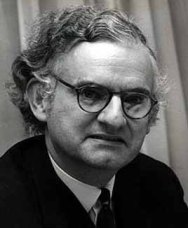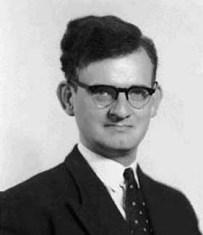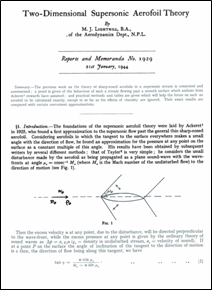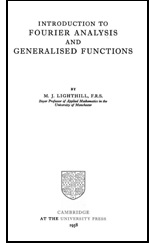 The website is in construction. New files will be uploaded as soon as they are available.
The website is in construction. New files will be uploaded as soon as they are available.
MICHAEL JAMES LIGHTHILL
Paris 1924 - Sark 1998

- Brief scientific biography
- Lighthill's work in mathematical education
- Essential bibliography
- Articles on the teaching of mathematics
Brief scientific biography
James Lighthill was born in Paris on 23 January 1924. After schooling at Winchester College, he won a scholarship to Cambridge, entering Trinity College in 1941. Due to the Second World War, his degree course was shortened by a year, so he graduated after just two years in 1943. He immediately joined the Aerodynamics Division of the National Physical Laboratory in Teddington as a junior scientific officer, staying until the end of the war, before returning to Cambridge as a fellow of Trinity College in 1945.
The following year he was appointed senior lecturer at the University of Manchester, being promoted to the Beyer professorship of applied mathematics in 1950. During his time in Manchester, he established a research group in fluid dynamics which, through its creativity and innovative work, soon exerted a dominant influence on hydrodynamic research worldwide. He left Manchester in 1959 to become the director of the Royal Aircraft Establishment at Farnborough.

The 1960s were among the most productive years of a very productive life. He was instrumental in the development of television and communications satellites, plans for manned spacecraft able to return to earth, and work on the joint British-French project which resulted in the Concorde supersonic passenger jet. Also during this time, in response to the lack of adequate government support for applied mathematics, he was the chief founder of the Institute of Mathematics and its Applications (IMA), serving as its first president from 1964 to 1966. In 1964, he returned to academia as a Royal Society research professor, based at Imperial College London.
In 1969, he replaced Paul Dirac as Lucasian Professor of Mathematics at Cambridge, being succeeded by Stephen Hawking in 1979 when he accepted the administrative position of Provost of University College London, which he also held for ten years. His mathematical research continued throughout his time as Provost, and when he finally retired in 1989, he remained active scientifically, holding an honorary research fellowship in the mathematics department at University College until his death in 1998.
Lighthill began to publish mathematical research almost immediately on joining the National Physical Laboratory,

While at Manchester, he was responsible for launching two new major fields of fluid mechanics. The first of these, aeroacoustics, was introduced in a two-part paper of 1952, entitled On sound generated aerodynamically. It was directly responsible for subsequent work in the field, proving to be of immense technological utility. In particular, "Lighthill's Law", which states that "the acoustic power radiated by a jet is proportional to the eighth power of the jet speed" (HUssAINI 1997, xxv), was of immediate importance in reducing jet-engine noise. He initiated the second area, nonlinear acoustics, in a famous 100-page paper in 1956, resulting in a host of subsequent research papers and applications in the study of traffic flow and flood waves in rivers.
During his time at Imperial College and at Cambridge, he totally transformed the subject of biological fluid dynamics to create what was, in effect, a new sub-discipline: mathematical biofluiddynamics. In this he developed new techniques to mathematically analyse blood flow in cardiovascular systems, respiratory flow, aquatic locomotion, and ciliary and flagellar propulsion. As with all of his work on fluid dynamics, this research was characterized by great insight, originality and interdisciplinary scope.
Widely regarded as one of the greatest applied mathematicians of the 20th century, Lighthill received an abundance of honours and awards from all parts of the world. Following his election to the Royal Society at the early age of 29, he was awarded honorary foreign membership by eleven learned societies in Europe, America and Asia, and was the recipient of twenty-two honorary doctorates. He received the Royal Society's Royal Medal in 1964, served as chairman of the Oceanography and Fisheries Research Committee from 1965 to 1970, and was president of the International Union of Theoretical and Applied Mechanics from 1984 to 1988. He was knighted by the Queen in 1971.
An enthusiastic and expert long-distance swimmer, in which his detailed knowledge of tides and local currents was used to good effect, in 1973 Sir James became the first person to swim the entire coast of Sark in the Channel Islands, a feat he subsequently repeated several times. On 17 July 1998, towards the end of another attempt to swim round the island, he suffered a fatal heart attack in rough seas and died close to the shore. He was 74.
Lighthill's work in mathematical education
Sir James was once accurately called "an amazingly extrovert and engaging personality" (THWAITES 1998, 497), and these qualities were undoubtedly reflected in his teaching style when lecturing on mathematics. Described as "a truly great teacher", for Lighthill, "the lecture-room's dais was a stage on which to perform with word and gesture alike so as to entrance the audience" (THWAITES 1998, 497). As Lucasian Professor at Cambridge, "he taught indefatigably and with enormous gusto six days of the week at nine in the morning" (CRIGHTON & PEDLEY 1999, 1228), and it would appear that he enjoyed every minute of it. For example, when teaching biofluiddynamics, "he revelled in lectures, not only in the articulation of all the Latin names, but in his ability to perform the appropriate gymnastics to illustrate certain flying characteristics" (CRIGHTON & PEDLEY 1999, 1227).His first book, Introduction to Fourier analysis and generalised functions (1958), grew out of undergraduate lectures

Sir James had a great interest in mathematical education at all levels. In the 1960s, he was involved in an advisory capacity in the creation of the School Mathematics Project, of which he was a trustee for many years. In 1970, he was elected president of Britain's Mathematical Association, being subsequently described as "the obvious choice for the Presidency of our Association in its Centenary Year" (THWAITES 1998, 497). His presidential address, delivered in 1971 at a meeting to mark 100 years of the association's activity, dealt with a subject of great interest to him: The art of teaching the art of applying mathematics.
One of the key problems when teaching applied mathematics, he said, is how to communicate the material to the students effectively.
"On the one hand, mathematics teaching should be permeated with concrete examples which give an impression of how widely and diversely mathematical ideas penetrate into human problems generally, including everyday matters and technical and scientific matters. On the other hand, it is necessary to tell at least one lengthy connected story of the application of mathematics in real depth, and to communicate the message that no-one can expect to solve the whole of any problem mathematically." (LIGHTHILL 1971, 256)In short, he said, to best convey the practice of applying mathematics, teachers must make integrated use of experiment, observation and theory in their classes. Not surprisingly, given the interdisciplinary nature of his research, he bemoaned the obstacles to closer connections between teachers of mathematics and subjects like physics, chemistry and biology caused by excessive departmentalisation. Despite this, he drew attention to what he believed to be a very positive feature of British mathematical education; namely, "the very close association between pure and applied mathematics, and a general predilection for teaching mathematics in a way that emphasised at least some of its applications" (LIGHTHILL 1971, 250). Characterising British mathematics teaching by its "flexibility", i.e. its focus on applications in a variety of practical and real-life situations, Lighthill observed that
"Now that the requirement for effective application in mathematics is found in so many fields, and the demand for people able and willing to apply mathematics has become so great, Britain's long experience in the field of integrated pure and applied mathematics education has become invaluable." (LIGHTHILL 1971, 251)He believed that the practical consequence of this would be that,
"In a century of rapid change, when the lifetime of a particular technology may be less than a person's working life, a flexibility in his education that prepares him to some extent for a possible vocational switch in middle life may be particularly valuable". (LIGHTHILL 1971, 254)But Lighthill's activities in mathematics education were not focused on Britain alone. "As in so many other fields, he played on the world stage" (THWAITES 1998, 497), and his presidency of the Mathematical Association was immediately followed by an even greater honour. In 1971, presumably in light of his high reputation in mathematics educational circles in Britain, he was elected to serve as the first British President of ICMI. In this capacity, he helped organise and chair the Second International Congress on Mathematical Education, held at Exeter in September 1972. After his presidential term expired in 1974, he remained an ex-officio member of the ICMI Executive Committee until 1978.
Essential bibliography
M. J. LIGHTHILL 1952-54, On sound generated aerodynamically, Parts I and II, Proceedings of the Royal Society, Series A, 211, 564-587, and 222, 1954, 1-32.
M. J. LIGHTHILL 1956, Viscosity effects in sound waves of finite amplitude, in Surveys in mechanics, ed. G. K. Batchelor & R. M. Davies, Cambridge University Press, 250-351.
M. J. LIGHTHILL 1958, Introduction to Fourier analysis and generalised functions, Cambridge University Press.
M. J. LIGHTHILL 1975, Mathematical biofluiddynamics, Philadelphia, Society for Industrial and Applied Mathematics.
M. J. LIGHTHILL 1978, Waves in fluids, Cambridge/New York, Cambridge University Press.
M. Y. HUssAINI, ed. 1997, Collected Papers of Sir James Lighthill, 4 vols., Oxford/New York, Oxford University Press.
B. THWAITES 1998, Sir James Lighthill F.R.S. 1924-1998, The Mathematical Gazette, 82, 496-497.
D. G. CRIGHTON, T. J. PEDLEY 1999, Michael James Lighthill (1924-1998), Notices of the American Mathematical Society, 46, 1226-1229.
Articles on the teaching of mathematics
M. J. LIGHTHILL 1971, The art of teaching the art of applied mathematics, The Mathematical Gazette, 55, 249-270.
Author
Adrian Rice
Randolph-Macon College, Ashland, Virginia
arice4@rmc.edu
